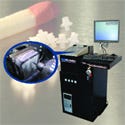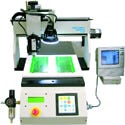Wireless data collected directly from patients during normal physical activities could enable the development of better knee implants
March 21, 2007
Originally Published MPMN March 2007
EQUIPMENT NEWS
Machining
Space-Saving Equipment Mills Small Parts
|
Based on the micromachine tool technology concept that a small part should be manufactured on small machines specifically designed for microscale manufacturing, a micromilling machine is 7–10 times smaller than its competitors, according to its manufacturer. The Model 310-S is a compact three-axis micromilling machine suited for the rapid prototyping of small plastic and metal parts. Working volumes for the x-, y-, and z-axes are 63 mm each. In addition, the unit boasts a 2-µm positioning accuracy, 0.02-µm resolution, and maximum acceleration of 5 g.
Features of the machine include a 160,000-rpm air-bearing spindle, granite support structures, open-architecture CNC, linear ac motors, and Heidenhain optical encoders on the x, y, and z stages. A quick-change high-repeatability workpiece and spindle-mount system enable easy removal and remounting of the workpiece pallet and spindle with submicron accuracy, according to the company. As a result, users can perform precision metrology by swapping out the spindle with a laser-metrology head, or can measure surface profiles of parts in process. Applications include the machining of injection-molded parts, such as hearing-aid components and microfluidic devices.
Microlution Inc., Chicago
www.microlution-inc.com
Five-Axis System Machines Complex Multisided Parts
|
A five-axis machining center is suited for use in medical applications requiring precision machining of complex multisided parts. A c-axis rotation of 360°, coupled with an a-axis of –3° to 100°, prevents numerous part-accessibility problems, according to the firm. The manufacturer also maintains that the VTXU model offers higher contour machining rates and provides better surface-finish capability than typical vertical machining centers configured with a C-frame design concept. Moreover, it is compatible with most five-axis CAM programs, and features a footprint of 107 × 156 in. and x, y, z travels of 31.5, 27.5, and 20 in. respectively. Additional characteristics of the unit include a maximum spindle speed of 12,000 rpm, a maximum spindle motor torque of 175 ft•lb at 720 rpm, a positioning of ±0.0002 in., and a repeatability of 0.0001 in.
Hurco Companies, Inc., Indianapolis, IN
www.hurco.com
Dispensing Robot Performs Drilling, Milling Operations
|
A benchtop robotic dispenser can be purposed for micromachining, PCB depaneling, and a variety of other drilling and milling applications. The RP-series machine features a preloaded machine-tool-quality gantry system with leadscrews in all three axes, and it ensures that products remain stationary on the solid machine base during fixturing and tooling procedures, according to the company.
Users can define cutting paths in their desired CAD program and then import them as .DXF, .HPGL, or G-Code files. The vision system is available for fiducial recognition when required as well. Programming experience is not required to operate the system, and a simple tool file control allows all machine properties to be set by layer or color in a CAD drawing. An onboard font generator included in the software can be used for product identification, serializing, and automatic date coding.
Dispense Works Inc., McHenry, IL
www.dispenseworks.com
Vertical Machining Centers Enable Large Mold Manufacturing
|
Two vertical machining centers aid in eliminating or reducing benchwork and postproduction polishing on large die and mold work, according to the manufacturer. The V99 is designed with x-, y-, and z-axes of 59, 39.4, and 31.5 in. and accepts a maximum workpiece of 70.8 × 39.4 × 25.6 in. that weighs up to 8800 lb. Alternately, the V99L model has x-, y-, and z-axes of 78.7, 39.4, and 31.5 in. with a worktable that accepts a maximum workpiece of 90.5 × 39.4 × 25.6 in. that weighs up to 8800 lb. Both versions offer a positioning accuracy of ±0.00006 in. and repeatability of ±0.00004 in.
The machines are available with a #40 taper, 20,000-rpm or a #50 taper, 12,000-rpm spindle. The #40 spindle accommodates tools measuring up to 4.7 in. in diam, 11.8 in. in length, and 12.7 lb in weight; the #50 allows for up to 5.7 in. in diam, 15.7 in. in length, and 44 lb in weight. A 30-tool automatic tool changer is standard for the machining center; however, options for 40, 60, and 80 tools are available, depending on the spindle configuration. Standard features also include a chip removal system and the Windows CE–based machine tool control platform.
Makino, Mason, OH
www.makino.com
Copyright ©2007 Medical Product Manufacturing News
You May Also Like






